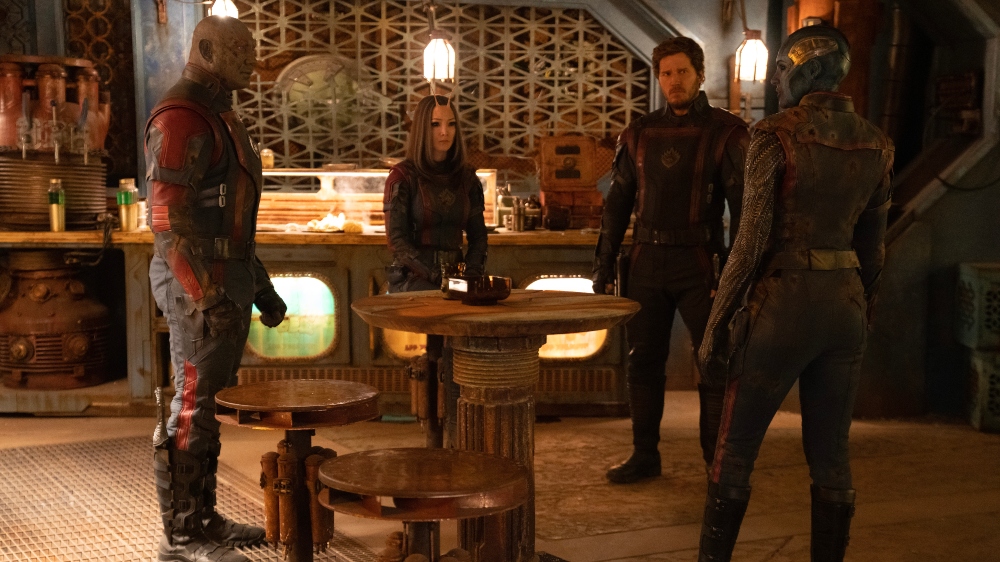
Beth Mickle never had designs on a career as a Production Designer. It just happened organically, as she teamed up — as a kid — with her brother Jim Mickle on his homemade films and then continued collaborating with him as he graduated to directing short films (The Underdogs) and indie horror movies. (Stake Land).
Similarly, Mickle herself made the leap from Ryan Gosling-led indies such as Half Nelson and Drive to studio movies like WB’s Focus and The Suicide Squad, which led to her current blockbuster, Guardians of the Galaxy, Vol. 3., a film that comes on the heels of her work on Marvel’s Guardians of the Galaxy Holiday Special.
Below the Line recently caught up over Zoom with Mickle, who connected from her home in upstate New York. Over the course of a half-hour, she discussed her start in the business, addressed the challenges of working on something as huge as Guardians, and shared her pride in the fact that — at her request, and with the support of both Marvel and Director James Gunn — there was gender parity within Vol. 3‘s Art Department.
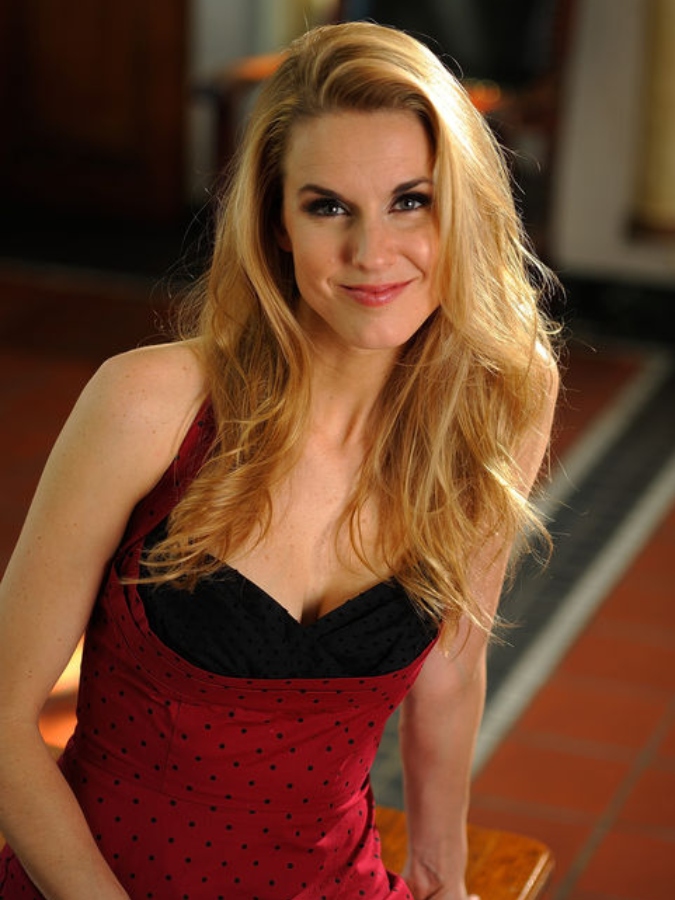
Below the Line: How and why did you get into the business?
Beth Mickle: I owe it entirely to my brother, Jim Mickle, who is a fantastic writer and director. He’s the director, showrunner, producer, and writer of Sweet Tooth on Netflix. It was a very special day in our household on April 27 this year. It was the premiere of Guardians and the release of the second season of his show. He just loved it.
When we were growing up, he was really interested in filmmaking. When we were 10, 12, 13… we had a little Super 8 camera out in our backyards, like many kids did in the ’80s and ’90s. Fortunately, I got swept along for the ride with him. I ended up doing mini-sets for his little short films that we would make. Then he went to film school and NYU, and I went to Columbia. I was studying art history and painting. Every weekend, he would have me come down and work on his student films. Thank God that was the case, because I just fell in love with it over and over every time.
One thing led to another and after doing enough student films with NYU folks, I ended up working with Ryan Fleck and Anna Boden, who did Half Nelson, and later, Captain Marvel, which introduced me to the comic book world. It’s been an amazing 20 years and I’m so grateful for all of the doors that have opened very serendipitously.
BTL: You didn’t learn your craft formally at school. So, whose work did you admire when you went to the movies? What did you pick up from what you saw?
Mickle: Dante Ferretti is one of the greats. Watching those Tim Burton films and seeing his work was one of the first examples that showed me that it doesn’t always have to be a living room in Kramer Vs. Kramer. It doesn’t always have to be a lawyer’s office. There actually can be these fun, imaginative sets and worlds. I loved his work.
I loved Dennis Gassner‘s work and Rick Carter‘s. I loved Patrizia von Brandenstein‘s work in Amadeus and just seeing how bright, colorful, and wonderful these worlds were. Once I started to see period and fantastical films — Spielberg, of course, and Tim Burton, [whose] Edward Scissorhands was one of the first ones that jumped out to me — I thought, “Oh, wow. There’s a whole imagination to be explored here and there literally are no limits.” That’s when I started getting interested in design.
I still remember to this day, whenever I watch the movie Indiana Jones and the Last Crusade, they go into this old, decrepit cave or cavern, and they’re looking at all these little Holy Grails to get one out. I remember sitting up — I was maybe 9 or 10 — and looking for little jewels, trinkets, gems, and tin foil, thinking, “How can I make little versions of that?” Those props were so spectacular. That was a real eye-opener. I remember that scene and those little hand props. That was a moment.
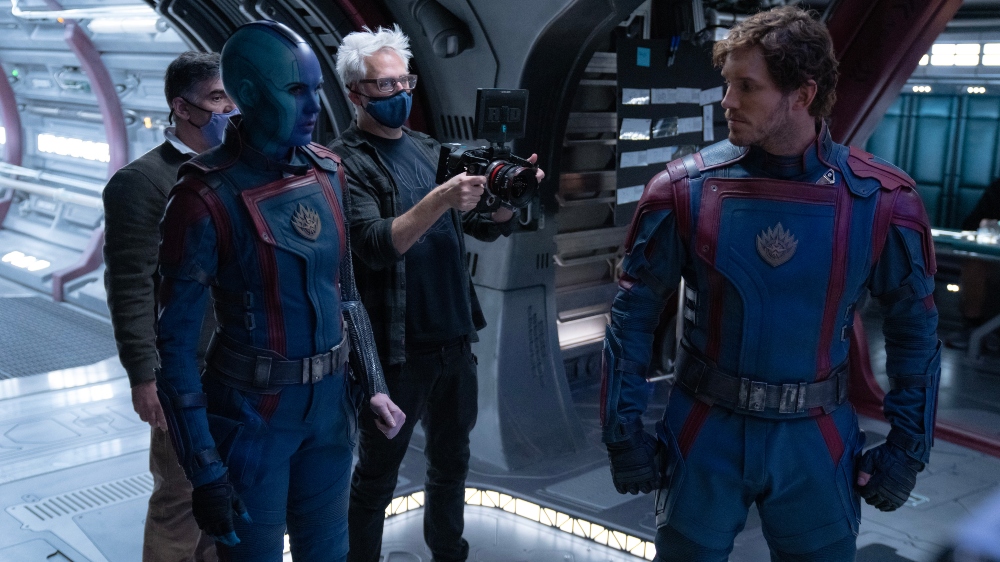
BTL: You came in very late to the Guardians franchise. How did it happen?
Mickle: I did. I was so incredibly fortunate that James [Gunn] wanted to hire outside of the box a little bit and didn’t want to go the route of the traditional production designers who tend to do these giant superhero movies. He wanted a wild card. Ryan Fleck and Anna Boden brought me in on Captain Marvel and so I was introduced to the Marvel team through that. Then it was Mary Livanos, one of the executives there at Marvel who, when James was looking for Guardians and he wanted somebody who wasn’t one of the usual suspects, said, ‘Well, here’s this girl. She did Drive.’ That was one of the only more notable things on my résumé at that time, aside from a few other smaller indies and studio films.
I’m so fortunate that James was willing to give me an opportunity, where not many women and not many independent film production designers get the opportunity to [work in] that arena. It blew the door wide open for me, James giving me that opportunity. I’m sure you know, there were only a handful of women [who] have done these movies and at that point, there had only been two before me. When I got the call for it, I remember thinking, “This will be an exciting thing to meet on, but the chances of them giving it to a young female who does independent films is unlikely.”
You should have seen me when I got the call saying he decided to hire me. I was on Motherless Brooklyn at the time, and I was driving across the Triborough Bridge. I swear, I almost swerved into the car next to me, I just couldn’t believe it. It’s changed my life and my career dramatically. I’m so grateful.
BTL: What do you think it was about your work that made you a wild card in James’ mind?
Mickle: I knew that he wanted to build a lot of sets. The tendency of some production designers in the giant world is to say, “Oh, it’ll be the effects,” or [to] design worlds knowing that they’ll become visual effects worlds because they’re so big. He was hopeful that — with my background being in real, physical sets and builds — that I would be more inclined to design sets with a [certain] scale, scope, and material finish that could actually physically be built. That was one of the reasons he went with a more independent film designer.
He also liked Nicolas Winding Refn‘s work, the director who did Drive. I also did Only God Forgives with him. Nic’s a phenomenal director [who] also goes for bold, vivid visuals, which is in line with James’ style as well. Those were the things that jumped out most and I was lucky working with Nic. Nic has you go into some wild, fantastical, strange, and unusual places. James enjoyed that in some of my past work.
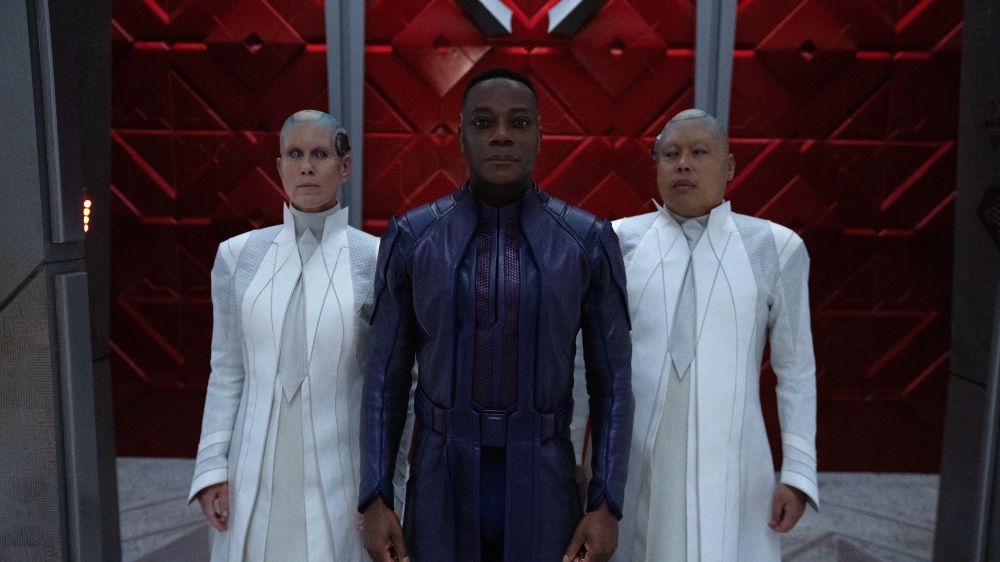
BTL: Even though you were creating practical sets, some of them still have to morph with the help of visual effects, which can amplify or complement what’s going on within the action on your sets. Can you break that down for us and explain how you work it all out for yourself in your head?
Mickle: Definitely designing within a footprint that feels buildable and tangible. That’s one of the first starting points — what can fit within a stage? James does these great breakdowns of the choreography [of each of the scenes and the shots within each of the sets. He does that often before the sets are even designed, as part of his early prep process. We want to make sure that everything we’re designing can accommodate everything that he has written and everything he’s imagining. That actually lays out a great roadmap.
Once we know what our footprint is, we look at his shot list and then we say, ‘Okay, this shot can [be] looking in this direction. Somebody can come around the corner from this side and they’ll meet here in the middle. Then somebody behind them comes through a window that we need right there.’ That helps us to lay out those broader building blocks.
We had fantastic partners in Stephane Ceretti and Susan Pickett — the Visual Effects team — where we would go, ‘Okay, with some of these interiors, we could build up to 15 or 20 feet, but then, could they extend the world out for us? Could they make something look like it went up five stories high? What could they put out the windows to help bring all these worlds into amazing scale?’
They were game for everything that we brought to them. It was a massive collaboration on so many levels and across so many departments, unlike anything that you end up doing in the independent world, for sure. Even on medium to larger studio movies, very few of them require the elaborate, in-depth planning and coordination that happens on a movie that’s this spectacular, specific, and impeccable. It’s an honor to be a part of it.
BTL: How did you handle the scenes where you had to design something that was not at all practical? My understanding is there’s not a ton of it, but there are a handful of scenes that were fully VFX.
Mickle: Yep, and that’s fantastic. It’s exciting because then you know that the sky’s the limit. You don’t have to worry about, “Are those materials we can find off a shelf in a store, or is a set going to fit into a stage?” It’s whatever your heart desires, and that is a dream come true for a Production Designer. What we would do for that is, we have a team of amazing Illustrators [who] I work with along with our Art Directors, [and] we will come up with the concepts and the designs, take them to James to get them approved, [and] then take them to the visual effects department to sit with them and talk about how they would be executed.
A lot of times, myself and our Art Directors actually sat on calls with the VFX houses [that] were going to be doing these three completely fabricated environments — Weta and Framestore, among others. It was great. We got to talk to them directly about, ‘Here’s what we imagine the finish is. Here’s what we imagine the layering is.’ We would also do samples of surfaces that the VFX department would scan.
A good example is the exterior of the Bowie spaceship. Of course, that was an all-CG item. We did surface finishes for the spaceships so that they could go in, scan, and match. One of my favorites was the big, giant, wide shot of the Orgo planet, the giant Orgoscope. You see that from miles and miles away from the spaceship view. That was actually something we’d drawn all the way back in 2018, and that was a design that stayed with us. It felt fun and original. We knew it was going to be very much up to the VFX department to be able to make it sing and, man, they did such beautiful justice to [it]. All of it.
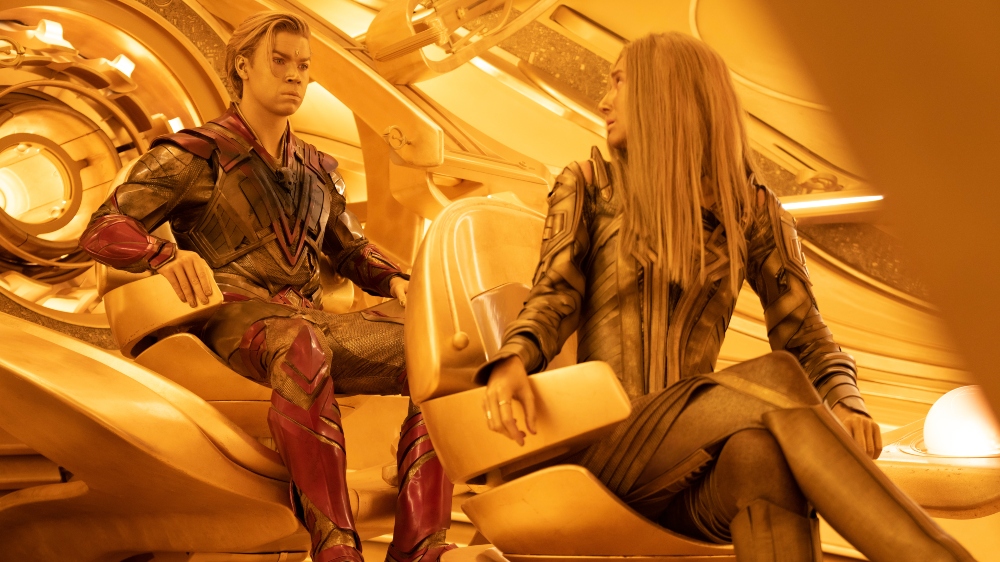
BTL: You’ve worked on small films in the past. What’s it like to work on a movie where, honestly, one set might cost more than entire films you’ve worked on years ago?
Mickle: It is the most mind-blowing experience. Let me think back to what the most recent one was. Just eight years ago, I did a $5-$6 million movie in New York. Before that, that’s all I did for the first 10 years. It’s wildly exciting to have the design be so uninhibited and to have no constraints. In the independent film world, the design often takes a backseat to what’s logistically the easiest, most financially responsible way to execute something. You’re often picking a location just because it’s close to another location. You can marry the two and shoot two scenes in a day. To have a lot of those constraints removed opens up the door to so many possibilities.
It was a big adjustment for me on The Suicide Squad to get out of the independent film mindset because I would always prioritize what logistically made more sense. I would always prioritize, “What’s the cheaper finish? What’s the cheaper option?” I was lucky to have great Art Directors with me over the last five years who would say, “No, we can afford that expensive tile” or “No, we can do gold leafing.”
‘That being said, it’s also incredibly important to me to keep doing small, independent movies in between these giant movies as much as I can because that’s where you have an appreciation for how far the dollar can go. That’s where you have an appreciation for creative solutions and creative thinking. I want those muscles to always be strong for me and I don’t want to lose any of that sharpness that I gained in the first 10-15 years of my career.
BTL: You mentioned Art Directors a few times now and you’ve mentioned Illustrators. Please give us some names. Who could you not have done your job without on Guardians 3?
Mickle: I could not have done it without Alan Hook and Dave Scott. I was so lucky I had two Supervising Art Directors. They were absolutely phenomenal in wrapping their arms around this gargantuan-sized film. Rosemary Brandenburg, our Set Decorator, as well. [She] works wonderfully with our department and brings every set to life, as soon as she goes in there and starts adding all of her layers.
The Illustrators — there are too many to name — but Fausto De Martini did the Bowie spaceship and he got there so quickly with the hand tool references that I sent him. It was within a matter of a few weeks that we ended up landing on that design. Samantha Avila, who [made] Knowhere five stories tall and 40,000 square feet. She ushered that along and was phenomenal. She did it and almost made it look easy, which was amazing. Alex McCarroll, who did our Bowie spaceship. What should have been a 20-to-24-week build, he crammed into 16 weeks. He did not sleep. There are many more, but Lorin Flemming, our Orgoscope Art Director, bravely took on the flesh and bone world and carried it across the finish line.
BTL: What was the ultimate “holy shit” moment for you on this movie when you saw one of your sets come to life — either during production or on the big screen?
Mickle: I’d say probably the most emotional was the opening shot when we’re on Rocket’s face; the opening shot once we get into the present day. We’re on his face and it’s his eyes, then it pulls back and it starts revealing this huge 40,000-square-foot set. Almost everything that was below four stories tall was a physical build. These were real walls that we had done. This was six months in the making. It was all of our blood, sweat, and tears, and all of our hearts poured into it. I had chills.
Knowing it was the first time that the world was going to get to see what we had been working on for so long, then to see all of our names come up in the credits and the opening, I started crying. My husband, who’s [also] a Production Designer, was sitting next to me holding my hand, and Judianna McCovsky, the Costume Designer, was sitting next to me holding my other hand. It was the most humbling, gratifying, [and] exciting experience of my entire career. I’ll never forget it.
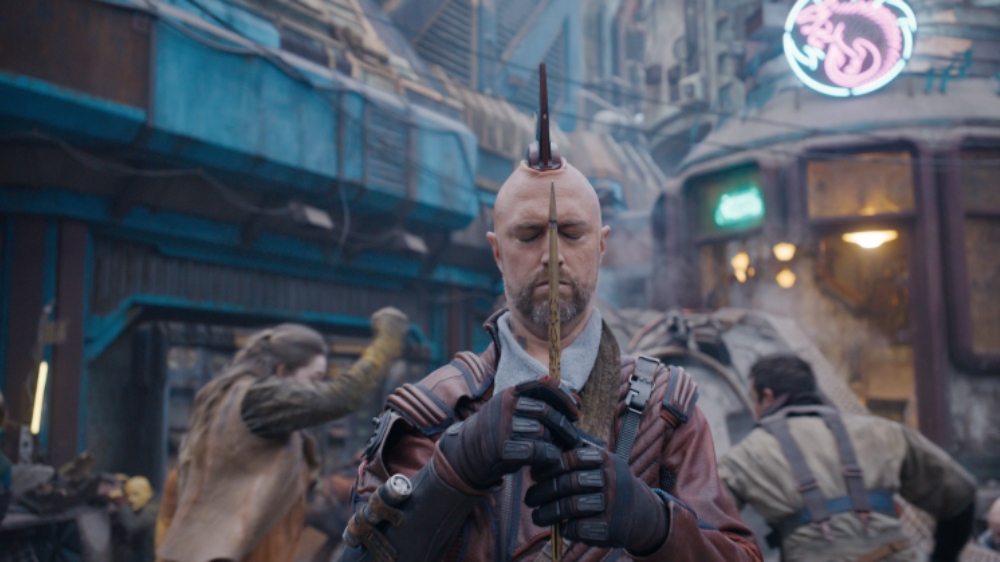
BTL: Let’s go the other way now. How much does it suck to spend six months on a set and then either have it blown to bits in a sequence, or finish shooting and watch as it’s struck?
Mickle: This is a great thing to be able to remember. I still remember sitting on Half Nelson, my very first feature film, and we’d done Ryan Gosling‘s apartment in this semi-abandoned building in Brooklyn. I remember Inbal Weinberg — a fantastic Production Designer; she was my Art Director at the time. We had spent a month putting this thing together and then they shot it. The movie was so special to all of us.
Then, just like that, we had to go in. She and I were pulling all the furniture out. I remember [that] we sat down on the couch and we started crying. At that point, it was just a month of our lives. We completely feel so much ownership of it and you just think, “How can this not go on to keep having a life beyond us?” Here, that was magnified a dozen times.
Knowhere is a good example. That was six months of conceiving, building, and getting it all just right. Then, it went through so many incarnations. We did the decorations for the Christmas Special, and then it gets blown up by the fights and all that. At the end, when they start pulling all the pieces out, they’re sweeping out the last bits of dirt, and it’s down to an empty stage… you’re almost in disbelief that this had happened. You almost feel like, “I wish I could have brought everybody I know here to walk around and to see this,” because people don’t believe that you could have actually done this in such a short timeframe in your life.
Every set is like a baby we’ve all given birth to and feel so much, like, pride and ownership over. It’s a piece of me. One of the things that I was happy to have was this great, machine-age industrial lamp in Rocket’s apartment. You see it for one moment on his work table, and I loved it so much. That was one of my little souvenirs. It just fell off the truck.
BTL: Megalopolis and Superman: Legacy are next for you. Where are things at with those projects?
Mickle: Megalopolis is in post. I know that they’re in the middle of post on that, so I’ll be very curious to see how that comes together. I’m excited to see the movie that Francis [Ford Coppola] puts together from all that we did there in Atlanta.
I’m just starting prep on Superman: Legacy. I can’t speak about the film at the moment, but all I can say is I’m so wildly excited for everybody to get to see the movie that we’re going to make.
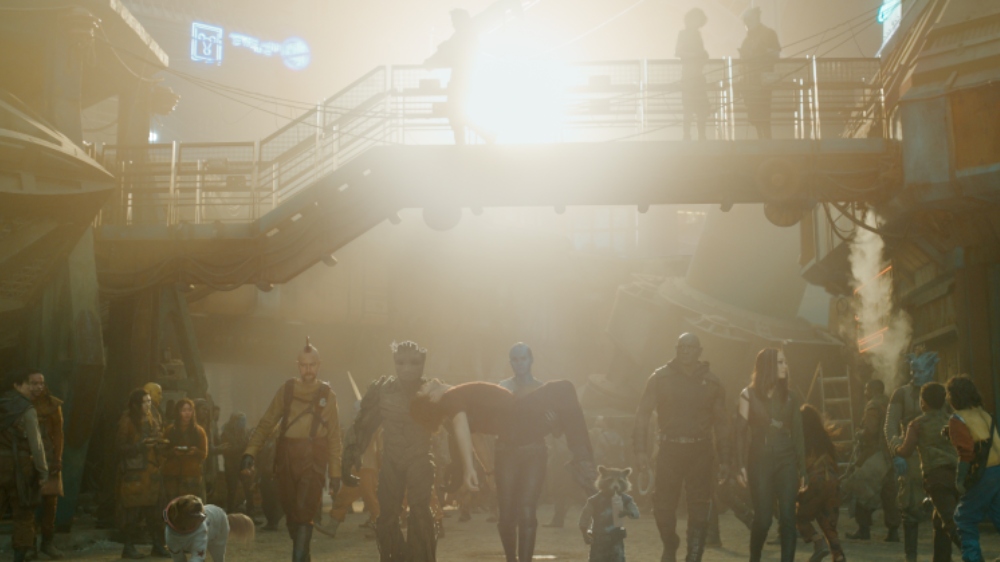
BTL: Since we’ve got a couple of extra minutes, is there anything I didn’t ask you about Guardians 3 that’s important to you or think people should know?
Mickle: Oh, thank you so much for asking. Seeing all the names, faces, and diversity that Marvel has been bringing on these last handful of years with their films, with directors like James, who are pushing for that, is a wonderful thing to see in the industry. It’s been a long time coming. I would like to say this — this is important to me: half of our art department on Guardians of the Galaxy [Vol. 3] was women. It was the first time I’d been in an art department office that was half women, half men, and [had] great representation across the board. It felt like, “Okay, this is the era that we’re coming into, where we have these great, wonderful, happy, equal playing grounds.” I was happy that we had that.
BTL: Did you hire those people? Was that you?
Mickle: Yes.
BTL: Did somebody say to you, “Go hire whomever you want,” and then you went and did that, or was there a mandate to have a 50-50 male-to-female ratio?
Mickle: No, that was me doing that, and I had great support [from] both Alan and Dave. I wanted the same on The Suicide Squad and we didn’t quite get to half, but we had a lot of women. We did have a lot of women on that show, [but] I said it again with Guardians. It’s important to me. It’s not lost on me that I’m one of the very few women getting the opportunity to do a film like this. Often, it’s literally 10 percent of an art department — or less — that is filled by women. I had great support [from] both Dave and Alan. We were so fortunate.
Once we started digging in and seeing all the amazing talent that was out there, and the diversity that came with it, it was exciting. I had one girl after another come up to me and say, ‘I’ve never had an art department office where we ran out of toilet paper in the girls’ bathroom. This is amazing!’ That was me pushing for that, with great support from my department and Marvel. I’m wildly proud of that. We’re actually on par to be doing the exact same with Superman: Legacy, so I’m very proud of that as well.
Guardians of the Galaxy Vol. 3 is now playing in theaters worldwide courtesy of Disney and Marvel Studios.





